Search results for: 'den'
-
 Golden fingerring in the shape of a snake
Golden fingerring in the shape of a snakeBeautiful gold ring from Egypt in Roman Imperial times. Published in the exhibition catalogue of the Basel Museum of Ancient Art.
Price: on request Golden fingerring in the shape of a snake
Golden fingerring in the shape of a snakeBeautiful gold ring from Egypt in Roman Imperial times. Published in the exhibition catalogue of the Basel Museum of Ancient Art.
Price: on request Tonstatuette des Harpokrates aus dem Fayum
Tonstatuette des Harpokrates aus dem FayumKurze Locken, darauf Blumenkranz mit Doppelkrone und zwei seitlich in den Kranz gesteckten Lotusknospen. Die Finger der rechten Hand sind vor den Mund geführt.
Price: on request Scarab with two cartouches of Thutmose III.
Scarab with two cartouches of Thutmose III.Interesting amulet from the New Kingdom or a later period made in archaic style. This scarab is described in the catalogue of Irène Gautier-Vodoz.
Price: on request Scarab with cartouche
Scarab with cartoucheAmulet from the Late Period. The stamp is in great condition. This scarab is described in the catalogue of Irène Gautier-Vodoz.
Price: on request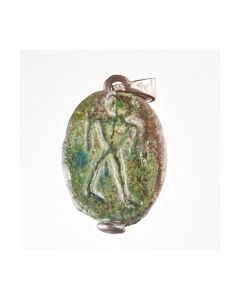 Scarab with standing figure
Scarab with standing figureThe scarab amulet dates to the Late Period. The lower side shows a stading figure, possibly the goddess Neith.
Price: on request Ägyptisches Zylindersiegel, 3.-2. Jt. v. Chr.
Ägyptisches Zylindersiegel, 3.-2. Jt. v. Chr.Zylinderförmiger Siegelkörper aus Fayence mit Taille. Die Flächen sind mit einem Ritzdekor verziert. Ex Sammlung J. Cummings.
Price: on request Ushebti für Wa-ibra-sa-Neith
Ushebti für Wa-ibra-sa-NeithGrabfigur aus Fayance, Spätzeit des Alten Ägypten, ca. 652-332 v. Chr.26. bis 30. Dynastie. Museale Erhaltung!
Price: on request Egyptian New Year flask with ornamentation
Egyptian New Year flask with ornamentationHieroglyphic inscription expressing New Year wishes for Ptah at the beginning of the nile floodings. Important 26th dynasty piece associated with the Egyptian New Year rituals. The object is a fantastic example of the skilled workmanship and artistic quality of faience in ancient Egypt.
Price: on request Scarab with breath of life
Scarab with breath of lifeThe Ankh on the bottom side of this ancient egyptian scarab symbolized life or afterlife. The symbol is framed by volutes.
Price: on request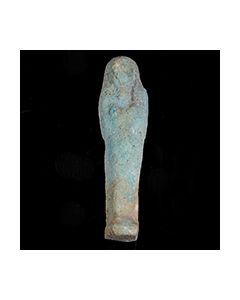 Uschebti aus der Ptolomäerzeit
Uschebti aus der PtolomäerzeitWeiß-grüne Fayence, Höhe ca. 7,4 cm, 4. Jh. v. Chr - 3. Jh. v. Chr., Ptolomäerzeit.Sehr gute Erhaltung, ausgearbeitete Gesichtszüge, vollständig intakt.
Price: on request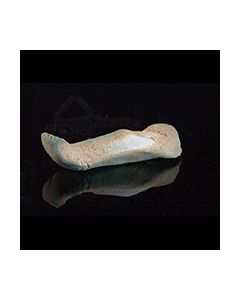 Uschebti aus der Ptolomäerzeit
Uschebti aus der PtolomäerzeitWeißlich-grüne Fayence, Höhe 5,2 cm, 4. - 3. Jh. v. Chr., Ptolomäerzeit. Faszinierendes Belegstück für die letzte Periode der klassischen ägyptischen Geschichte.
Price: on request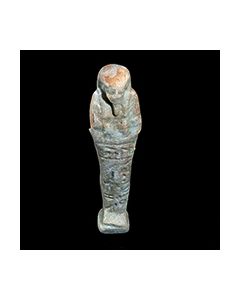 Uschebti mit hieroglyphischer Inschrift
Uschebti mit hieroglyphischer InschriftGrüne Fayence mit Hieroglyphen, ca. 10cm groß, intakt und nicht restauriert. 664 v. Chr. - 525 v. Chr., 26. Dynastie, Beginn der Spätzeit.
Price: on request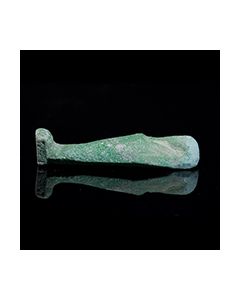 Uschebti aus der Ptolomäerzeit
Uschebti aus der PtolomäerzeitGrüne Fayence, intensive Farbe der Glasur, sehr schöne Züge. Vollständig intakt, nicht restauriert. Ptolomäerzeit, 4.- 3. Jh. v. Chr.
Price: on request Ushabti-Figur, hellgrüne Fayence
Ushabti-Figur, hellgrüne FayenceIntensiv kolorierte Figur mit schwarzem Ständer, Ägypten, Spätzeit
Price: on request Prachvoller Ushebti mit Hieroglyphen
Prachvoller Ushebti mit HieroglyphenDetailliert gearbeitete Figur mit vollständig erhaltener, stellenweise noch glänzender Glasur und Hieroglyphen auf der Rückseite.
Price: on request Große Ushabti-Figur
Große Ushabti-FigurInteressanter Ushebti in perfekter Erhaltung, detailliert gearbeitet, Ägypten, Spätzeit, 26. Dynastie
Price: on request Uschebti, ägyptische Totenfigur
Uschebti, ägyptische TotenfigurSchöne mintgrüne Fayence, erkennbare Gesichtszüge. Höhe 85mm. 26. - 30. Dynastie, Spätzeit.
Price: on request Egyptian ushabti for Ra-mes
Egyptian ushabti for Ra-mesThe mummiform funerary figurine dates to the Late Period of ancient Egypt, 26th to 31st dynasty. It is remarkable that it probably originates from the burial of two brothers, Ra-mes and Somtus-tefnacht.
Price: on request Ushabti for Ra-mes
Ushabti for Ra-mesThe mummiform funerary figurine dates to the Late Period of ancient Egypt, 26th to 31st dynasty. It is remarkable that it probably originates from the burial of two brothers, Ra-mes and Somtus-tefnacht.
Price: on request Egyptian ushabti for Somtus-tefnacht
Egyptian ushabti for Somtus-tefnachtThe mummiform funerary figurine dates to the Late Period of ancient Egypt, 26th to 31st dynasty. It is remarkable that it probably originates from the burial of two brothers, Somtus-tefnacht and Somtus-tefnacht.
Price: on request Egyptian ushabti for Somtus-tefnacht
Egyptian ushabti for Somtus-tefnachtThe mummiform funerary figurine dates to the Late Period of ancient Egypt, 26th to 31st dynasty. It is remarkable that it probably originates from the burial of two brothers, Somtus-tefnacht and Somtus-tefnacht.
Price: on request Egyptian ushabti for Somtus-tefnacht
Egyptian ushabti for Somtus-tefnachtThe mummiform funerary figurine dates to the Late Period of ancient Egypt, 26th to 31st dynasty. It is remarkable that it probably originates from the burial of two brothers, Somtus-tefnacht and Somtus-tefnacht.
Price: on request Ushabti for Somtus-tefnacht
Ushabti for Somtus-tefnachtThe mummiform funerary figurine dates to the Late Period of ancient Egypt, 26th to 31st dynasty. It is remarkable that it probably originates from the burial of two brothers, Somtus-tefnacht and Somtus-tefnacht.
Price: on request Egyptian ushabti for Somtus-tefnacht
Egyptian ushabti for Somtus-tefnachtThe mummiform funerary figurine dates to the Late Period of ancient Egypt, 26th to 31st dynasty. It is remarkable that it probably originates from the burial of two brothers, Somtus-tefnacht and Somtus-tefnacht.
Price: on request Egyptian ushabti for Somtus-tefnacht
Egyptian ushabti for Somtus-tefnachtThe mummiform funerary figurine dates to the Late Period of ancient Egypt, 26th to 31st dynasty. It is remarkable that it probably originates from the burial of two brothers, Somtus-tefnacht and Somtus-tefnacht.
Price: on request Egyptian ushabti for Somtus-tefnacht
Egyptian ushabti for Somtus-tefnachtThe mummiform funerary figurine dates to the Late Period of ancient Egypt, 26th to 31st dynasty. It is remarkable that it probably originates from the burial of two brothers, Somtus-tefnacht and Somtus-tefnacht.
Price: on request Egyptian ushabti for Ra-mes
Egyptian ushabti for Ra-mesThe mummiform funerary figurine dates to the Late Period of ancient Egypt, 26th to 31st dynasty. It is remarkable that it probably originates from the burial of two brothers, Ra-mes and Somtus-tefnacht.
Price: on request Polychromic sarcophagus mask from Ancient Egypt
Polychromic sarcophagus mask from Ancient EgyptBemalte Holzmaske aus ptolemäischer Zeit. Kunstvoller Sarkophagschmuck in museumswürdiger Erhaltung. Ca. 18cm lang, 11cm breit.
Price: on request Ägyptischer Ushebti mit T-förmiger Inschrift
Ägyptischer Ushebti mit T-förmiger InschriftTotenfigur aus mintfarbener Fayence mit hieroglyphischer Inschrift, 28. bis 30. Dynastie, Spätzeit. 105mm hoch.
Price: on request Egyptian amulet of a hare
Egyptian amulet of a hareThis type of amulet was popular in the Late Dynastic Period of Ancient Egypt. It should endow its wearer with fertility and rapidity of movement. The piece was exhibited in an early 20th century private museum.
Price: on request Bronze statuette of nursing Isis
Bronze statuette of nursing IsisIsis is shown in a very typical depiction as a mother, the archetype of the later Christian Nursing Madonna. The bronze figurine dates to the 22nd to 31st dynasty of Ancient Egypt.
Price: on request Bronze statuette of Osiris
Bronze statuette of OsirisThe figurine is in exceptional condition with a nice patina. Late Dynastic period of Ancient Egypt, 664 to 332 BC.
Price: on request Egyptian sarcophagus mask
Egyptian sarcophagus maskImpressive wood relief of an idealized face. Polychrome paint. The mask was part of a sarcophagus lid from the Late Period of Ancient Egypt.
Price: on request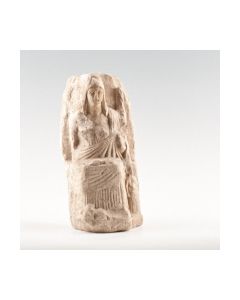 Stone statue of a seated Isis
Stone statue of a seated IsisVery fine condition, from an important London collection
Price: on request Egyptian tomb relief from Memphis
Egyptian tomb relief from MemphisThe flat relief shows an offering scene and above a hieroglyphic text describing the deceased Ptah-nefer, the priest and the offerings. A translation has been made by the renowned Egyptologist professor Kurth. The work of art dates to the 26th dynasty. It is adopting the style of the Old Kingdom.
Price: on request

